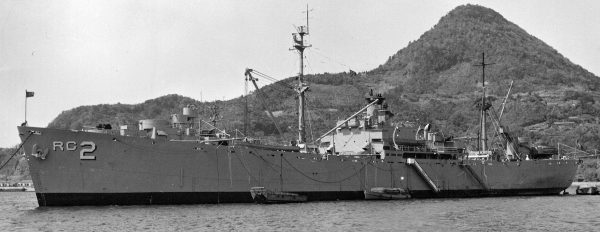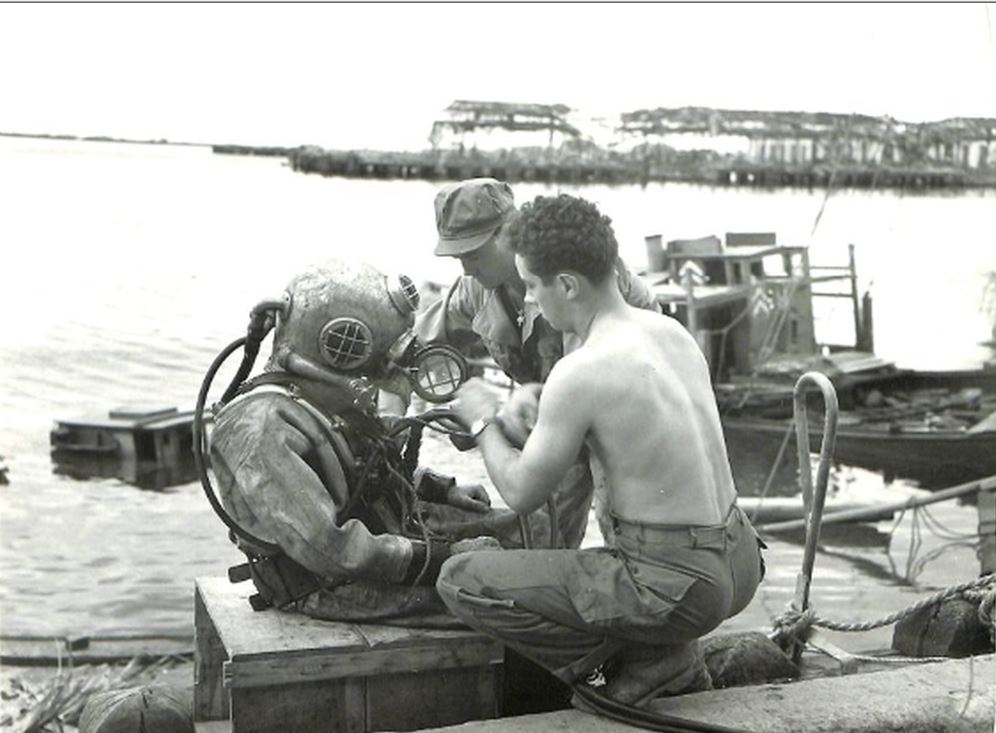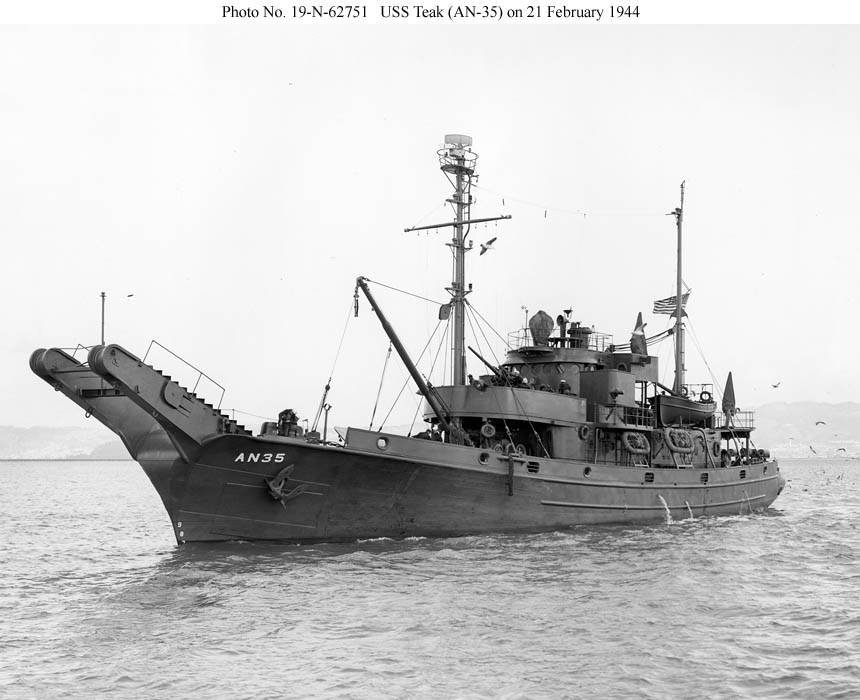
Manila Bay Harbor Clearance
Zo625. One of many sunken ships, wrecks then, blocking the Manila Harbor in WWII. Image, curtesy of Pacific Paratrooper webpages.
———————————————
Eye Witness Account – Clearing Manila Harbor, lets start with this story.
This is condensed from a story written by Rear Admiral William A. Sullivan and appears in “The Pacific War Remembered” edited by John T. Mason Jr.
These first five pictures and story came from this Pacific Paratrooper website or click here:
Eye Witness Account – Clearing Manila Harbor
Note from Karl: Diving and salvage are of special interest to me. I served as a diver in every one of my duty stations. I served on three different Diving and Salvage Ships. After retirement I had time to look at history and some of it dealt with diving and salvage.
—————————————–

Zo626. Crossing the Pasig River, this is neat, this is one of “Do It Yourself Type”. Image, curtesy of Pacific Paratrooper webpages.
Our most important job in Manila was the opening of the main harbor entrance. The Japanese did a perfect job blocking it – far more efficient than any similar job the Germans had done in Europe. There were 5 ships sunk in a staggered line across the entrance. Four of them were old inter-island ships and one was the Luzon, flagship of the Yangtze patrol. I had the steering wheel of the Luzon taken off and sent to the naval Academy Museum.

Zo627. USS Luzon, former flagship of the Yangtze patrol. Image, curtesy of Pacific Paratrooper webpages.
About this time, Doc Schlesinger advised me to get the men out of the tents they had been living in and put them in solid buildings before rainy season hit. Requisitions for lumber were ignored. The lumber was being unload by the SeaBees to build a tremendous 7th Fleet Headquarters.
I watched them and every afternoon at 4:00 pm, they knocked off and went back to their billets. One night a lighter was not properly secured and drifted loose. I sent our boat over to it. Just what we needed! The next morning, the SeaBees returned and went to work as usual.
I turned it all over to our firefighters and the houses got built by mostly Filipino carpenters and guerrillas. No one in the Navy asked where I got the lumber. The only who asked was General Casey, MacArthur’s chief engineer. I told him I stole it from the Navy as the Army was short, so I couldn’t have stolen any from them.

Zo628. The great Manila Silver Operation. Image, curtesy of Pacific Paratrooper webpages.
We had a job which received much publicity, the recovery of silver pesos from the waters around Corregidor. I asked MacArthur about using Army divers, but he didn’t want the job of Manila Bay neglected. A week or two later, he brought the subject up again. He said the money had been removed from Manila bank before the Japanese complete take-over. The money was dumped by barges, something like 13 million dollars’ worth. The United States had both a legal and moral obligation to recover it.
I made up a team of divers and gave the CO of the ARS his orders and he left with an Army finance officer and a MP. They found no silver. An Army Sgt., Bataan Death March survivor, recently released POW, who had worked on the barges, marked the chart with an X. He also said the Japanese had recovered some of the silver themselves.

Zc378. A small U.S. Navy diving and salvage ship; photo credit-the above Pacific Paratrooper web page and LIFE Magazine. If you look closely, then you will understand why we Navy Divers called our Diving Navy ships: “Junk Boats”. We believe this is the USS Teak AN-35(Auxiliary Net-laying).
Finally, after many dives, the wooden boxes were located at 90 to 130 feet down, deteriorated and broken apart. The divers had to sift the silt on their hands and knees. The recovery of the silver continued through my stay. When I left the Philippines (August 1945), I believe something like 7 million dollars in pesos had been recovered.
Rear Admiral William Sullivan
Born and raised at 160 S. Broadway. Educated at Wetherbee School and Lawrence High School. Graduated from Phillips Academy in Andover and the Massachusetts Institute of Technology in Cambridge, 1917.
Enlisted in the Navy after graduating from college and worked at various shipyards in the United States and the Philippines. Head of the Salvage Branch, Bureau of Ships, including the preparation for raising the USS Lafayette at Normandy.
Supervised harbor cleaning operations at Casablanca in 1942.
Organized Naval Training School (Salvage) at Pier 88 in New York, and lectured on salvage and naval architecture to the first class.
Assigned to the Allied naval forces in the Mediterranean, reporting to General Dwight Eisenhower. Named commander of all U.S. and British salvage ships under Eisenhower.
Worked with General Douglas MacArthur at San Fernando and Manila as commander of Task Group 122.2 at Normandy, Omaha and Utah Beach.
Received the Distinguished Service Medal; Legion of Merit and the Naval Unit Citation; Commander, Order of the British Empire; Legion of Honor Croix de Guerre with Palm by France; and High Official, Order of the Crown of Italy.
Died September 6, 1985 in La Jolla, California. Buried at Arlington National Cemetery; “Father of the Navy Salvage” inscribed on his monument.
Memorialized with a plaque on Pier 88 in New York, Sept. 26, 1992.
———————————————————–
Navy divers, dive on Japanese wreckage near Pier 7, Manila. 1945
Bob Hudson sent me these pictures, thank you Buddy.

Zc775. U.S. Navy Deep Sea Diver diving on a sunken Japanese vessel next to Pier 7 in1945 at Manila. If I had been born earlier and on the right side of the war it could have been me. I was a U. S. Navy Deep Sea Diver (Hard Head Diver) after the war. That hard head rig weighed about 193 pounds; it was not easy to walk up a ladder with that rig. Bob Hudson provided this picture; he has an interesting web page, or click here:
http://bataanson.blogspot.com/

Zc776. U.S. Navy Deep Sea Diver diving on a sunken Japanese vessel next to Pier 7 in1945 at Manila. Did you know that the U.S Navy Deep Sea Divers were not required to know how to swim? When SCUBA diving was adopted, swimming became a prerequisite and some of the divers had to learn how to swim. Bob Hudson provided this picture.
———————————————————–
Navy Salvage Ships in action!
These next 7 pictures are curtesy of NavSource Online: Service Ship Photo Archive or click here:
http://www.navsource.org/archives/09/18/18035.htm

Zo629. In my search of history, I learned it was put to work in Manila Bay 1945, to help clear the bay from the Japanese sunken ships. Here is USS Teak (AN-35) near the Mare Island Navy Yard, 21 February 1944, after alterations.
US National Archives, RG-19-LCM, Photo # 19-N-62751 a US Navy Bureau of Ships photo now in the collections of the US National Archives. Mike Green.

Zo630. Broadside view of USS Teak (AN-35) in San Francisco Bay, 21 February 1944.; Navy Yard Mare Island photo # 1224-44; SourceDarryl Baker.
Specifications: Displacement 700 t.(fl) 805 t.(lim); Length 162′ 2″”; Beam 30′ 6″; Draft 11′ 8″ (lim); Speed 12.5 kts. (trial); Complement: Officers 4, Enlisted 44; Armament: one single 3″/50 dual purpose gun mount; two .50 cal machine guns, one y-gun; Largest Boom Capacity 12 t.; Propulsion: one General Motors 6278 Diesel-electric engine; Fairbanks Morse Main Reduction Gear; Ships Service Generators: three Diesel-drive 60Kw 120V D.C.; single propeller, 800shp; Fuel Capacity 620 bbls.

Zo631. USS Teak (AN-35) clearing wrecks in Manila Bay, Philippine Islands during March and April 1945.
Image series by Carl Mydans, Life Magazine, used for educational and non-commercial purposes. Source-John Chiquoine.

Zo632. USS Teak (AN-35) clearing wrecks in Manila Bay, Philippine Islands during March and April 1945.
Image series by Carl Mydans, Life Magazine, used for educational and non-commercial purposes. Source-John Chiquoine.

Zo633. USS Teak (AN-35) clearing wrecks in Manila Bay, Philippine Islands during March and April 1945.
Image series by Carl Mydans, Life Magazine, used for educational and non-commercial purposes. Source-John Chiquoine.

Zo634. USS Teak (AN-35) clearing wrecks in Manila Bay, Philippine Islands during March and April 1945.
Image series by Carl Mydans, Life Magazine, used for educational and non-commercial purposes. Source-John Chiquoine.

Zo635. USS Teak (AN-35) clearing wrecks in Manila Bay, Philippine Islands during March and April 1945.
Image series by Carl Mydans, Life Magazine, used for educational and non-commercial purposes. Source-John Chiquoine. This work with wire and in this tight space was my bread and butter in the US Diving and Salvage Navy and as a Boatswain’s Mate I was The Specialist!

Zo588. Whoops, wrong picture! What the heck, that’s me as a First-Class Navy Deep Sea Diving Student on the Potomac River. We are doing our salvage training here 1969 at a deep spot in the river. This is also at the Naval Dahlgren Weapons Station and later, 1970, I helped here raising the ex USS Reuben James, which sunk here after explosion testing effects. This ship’s name also has a German WWII connection; an earlier Reuben James, a Destroyer, DD-245 was torpedoed in Oct 1941 by a German submarine with the loss of 100 men or more. The ship was doing convoys to Great Britain escort duty up to Iceland before the US entered the war. The ship was named after a Navy Boatswains Mate, that is what I was at the time, a Chief Boatswains Mate Diver, (BMC DV2).
————————————————–
Salvage of wreck on Corregidor 2008
Not all wrecks have been cleared out of Manila Bay. Some are historical, such as the SS Corregidor or the Drydock George Dewey.
This salvage work occurred on Corregidor Island, the ex-Fort Mills in Aug 2008. I was visiting Corregidor at this time and took these pictures between Aug. 18 to Aug. 20 2008. This wreck, it must have been from WWII, from the Siege of Corregidor, was resting on the east end of the former Ft. Mills North Mine Dock. It was interesting to watch Filipino Divers at work.
This must have been a job to make the water at the east end of the Mine Dock navigable for deeper draft vessels. The NE corner of the North Mine Dock also got repaired after the salvage work!
I generated an album and made a thread in the forum with 20 images, take your pick, or click here,
or click here:
Uploaded to Karl’s web page:
Uploaded to the forum:
https://corregidor.proboards.com/thread/2273/salvage-wreck-on-corregidor-2008
For this presentation I added these 2 images:

Zo640. A WWII wreck, sunk during the siege of Corregidor, is salvaged on Corregidor Island, Manila Bay in 2008.

Zo646. A map of Corregidor Island, the former Ft. Mills. A WWII wreck, sunk during the siege of Corregidor, is salvaged on Corregidor Island, Manila Bay in 2008.
————————————————-
The Great Silver Recovery Job in Manila Bay 1945.
The pictures came from this Facebook page or click here:
https://www.facebook.com/groups/ww2pinas/permalink/3051508064912004/
I understand the pictures original came from the Life Magazine, photographer Karl Mydan Series of pictures. I got aware of them in the WWII Philippines Facebook pages and apparently a gentleman from East Europe posted them. He posted 20 pictures; I choose 6 to be presented here,
If you want to know more about the Corregidor Treasures in Manila Bay, these two webpages should be your choice, or click here:
https://corregidor.proboards.com/thread/2126/corregidor-treasures-pictures-links

Zo656. A screen shot of the WWII Philippine Facebook webpage with the address of the East European Gentleman who posted the pictures.

Zo657. This is the focsle of USS Teak AN-35, Net tender, recruited for this salvage job. There may have been other ships. A Navy deep sea diver is getting dressed into the MK-V Hard Hat Rig. This is the Philippine Silver Recovery in 1945, image curtesy as stated above.

Zo658. A Navy deep sea diver is going over the side in San Jose Bay between Corregidor and Caballo Islands in 1945. I back we see the 92 Garage area on Corregidor and Mt. Limay on Bataan behind the diver. This is the Philippine Silver Recovery in 1945, image curtesy as stated above.

Zo659. A Navy deep sea diver is going over the side in San Jose Bay between Corregidor and Caballo Islands in 1945. This diver seems to take a long a metal search gadget. This is the Philippine Silver Recovery in 1945, image curtesy as stated above.

Zo660. A Navy deep sea diver almost dressed on the USS Teak AN-35 at San Jose Bay between Corregidor and Caballo Islands in 1945. Doesn’t he wish? But I’m sure the authorities let the sailors have a few souvenirs. This is the Philippine Silver Recovery in 1945, image curtesy as stated above.

Zo661. Philippine silver by the bucket and heaps. There was also gold involved. If you like to know more, dig in the three URLs above. This is the Philippine Silver Recovery in 1945, image curtesy as stated above.
——————————————————
Manila Bay ship clearing – March 1945
I thought this was about diving and salvage of all the ships sunk. I was wrong, read on. They called in the Army Specialists!
This presentation shows pictures from this Facebook Group “WORLD WAR PICTURES”. Peter Deforest runs this group. EXO says it is a French site but all writing is in English.

Za534 Manila Bay ship clearing from World War Pictures by Peter DeForest.
I was trying to find the album about Gen MacArthur on Corregidor, this Facebook group already has 166 albums and I got sidetracked looking at this one: Manila Bay ship clearing – March 1945 or click here:
www.facebook.com/media/set/?set=oa.325706684559965&type=3
Note from Karl; I understand to look at Facebook material you got to have a Facebook account. And to look at posts of the Facebook groups you got to sign up. I did, it took only 3 minutes and they asked why I wanted to look.

Za538. Manila Bay ship clearing from World War Pictures by Peter DeForest.
Approaching the target and brought insurance along. This picture is one of 31 images in an album called: Manila Bay ship clearing – March 1945. It is part of the World War Pictures, a Facebook group by Peter DeForest. In the album it is explained as to what kind of gun this is!

Za539. Manila Bay ship clearing from World War Pictures by Peter DeForest.
Alongside the target. This picture is one of 31 images in an album called: Manila Bay ship clearing – March 1945. It is part of the World War Pictures, a Facebook group by Peter DeForest.

Za540. Manila Bay ship clearing from World War Pictures by Peter DeForest.
Falling back on Plan B. This picture is one of 31 images in an album called: Manila Bay ship clearing – March 1945. It is part of the World War Pictures, a Facebook group by Peter DeForest.

Za541. Manila Bay ship clearing from World War Pictures by Peter DeForest.
Executing Plan B- not to surrender does not pay! This picture is one of 31 images in an album called: Manila Bay ship clearing – March 1945. It is part of the World War Pictures, a Facebook group by Peter DeForest.
This is the URL for the album listing site of World War Pictures by Peter DeForest or click here.
www.facebook.com/groups/195467287583906/photos/?filter=albums
I am 39 year old mom Thank you so much!